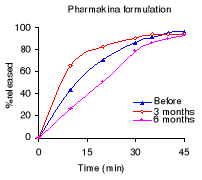6.2.2 Results
The RSD was 0.65 % within a day and 1.67% within three days,
which complies with the USP 24 requirements (RSD should be less than 2%).
The results of the drug content (Table 6.1) show that all
formulations complied with the USP 24 specifications for quinine sulfate
content: 90% - 110% of the labelled amount of quinine sulfate. Whereas the
content of the Labophar tablets was just above the lower limit of the required
interval before stability testing, it failed after six months of storage at
40° C and 75% RH.
Table 6.1: The quinine content (expressed as
percentage of the labelled amount) before and after 6 months of storage at
40°C and 75 % RH.
Manufacturer
% of the labelled amount per tablet
0 months 6 months
Elys Chemicals
105.0 98.1
Labophar
90.2 86.4
Pharmakina
97.0 94.6
II.6.3. In vitro dissolution
6.3.1 Methods
· Preparation of dissolution
medium
98.64 ml of 37% hydrochloric acid was diluted to 10.0 L with
distilled water. The resulting 0.1N hydrochloric acid solution was used as
dissolution medium.
· Calibration curve
Stock solution
40 mg of quinine sulfate was accurately weighed and
transferred to a 25 ml volumetric flask and dissolved to volume using the
dissolution medium. 1 ml from the above solution was diluted to 100.0 ml to
give a stock solution with a concentration of 16 mg/l.
Standard solutions
4, 8, 10, 16 and 20 ml from the stock solution were separately
diluted to 20.0 ml to give standard solutions with concentrations of 3.2, 6.4,
8.0, 12.8 and 16.0 mg/l.
A calibration curve (absorbance vs. concentration) y = 0.0925x
+ 0.0053 with a correlation coefficient (R2) of 0.9999 was
constructed.
· Dissolution testing
Dissolution profiles were determined using the USP basket
method (Method 1). Each of 6 tablets was added to a basket connected to a
stirring shaft which was placed inside a dissolution vessel filled with 900ml
of dissolution medium maintained at 37 0.5°C. The rotation speed was 100
rpm. At 10, 20, 30, 35, 40 and 45 min 5 ml samples were withdrawn, filtered,
diluted (1:40) and spectrophotometrically analyzed at 248 nm.
6.3.2 Results
Table 6.2 shows the percentage dissolved within 45 minutes of
dissolution testing and Figure 6.1 the different dissolution profiles. Before
stability testing all drugs complied with the USP 24 dissolution requirements
(not less than 75% of the labelled amount should dissolve within 45 minutes).
The amount of drug released after 45 minutes of dissolution test was more than
80% for all formulations. The Elys formulation was affected by stability test
conditions, the drug percentage released decreased from 103.2% to 41.8% after 6
months. For the others, the drug released remained within USP 24 tolerance
limits for dissolution testing.
Table 6.2: Percentage of quinine dissolved within 30 minutes
of dissolution testing before and after 3 and 6 months of storage at 40°C
and 75% RH. USP requirements: more than 75 % released within 45 minutes.
Manufacturer
% of the labelled amount per tablet
0 months 3months 6 months
Elys Chemicals 103.2
69.6 41.8
Labophar
88.2 85.6 85.0
Pharmakina
96.1 94.0 92.7

Figure 6.1 Quinine dissolution profiles before, after 3 and 6
months of storage at 40°C and 75 % RH.


| 


